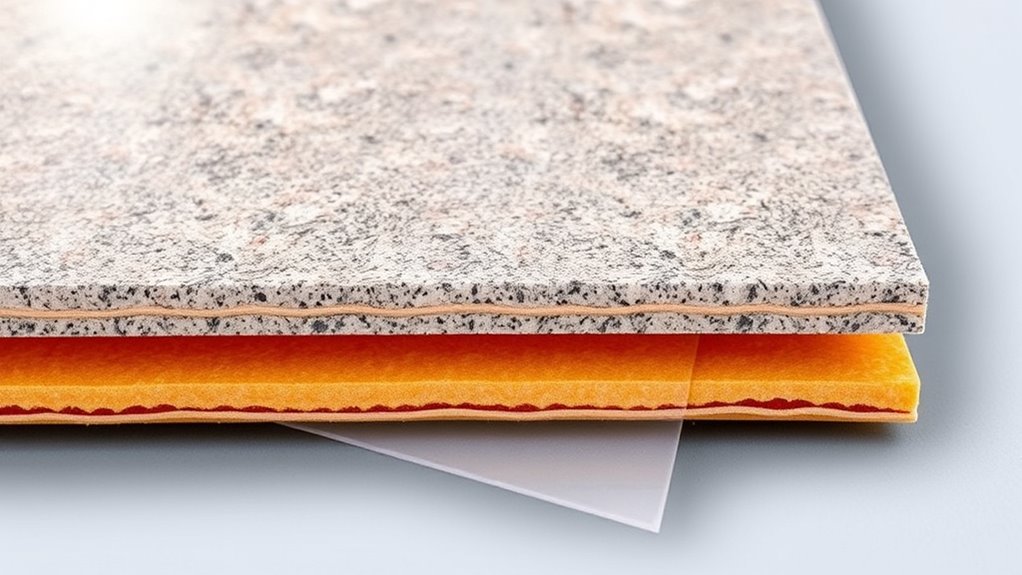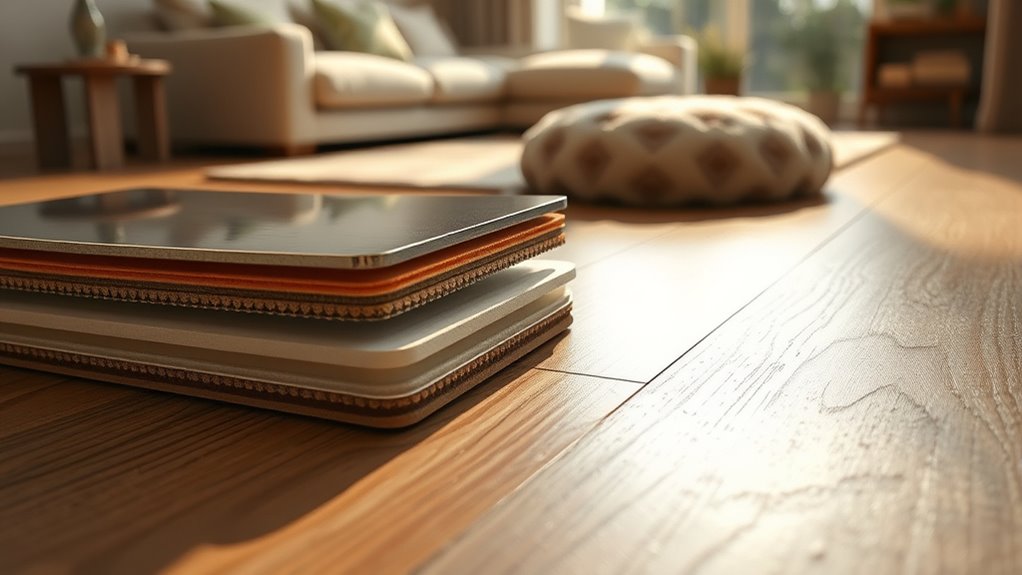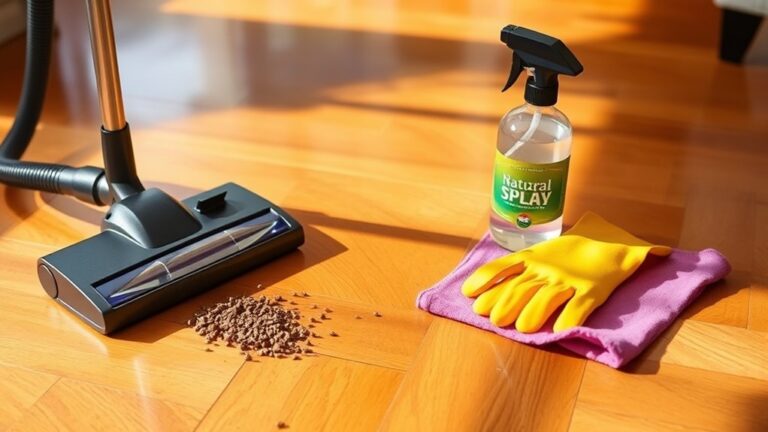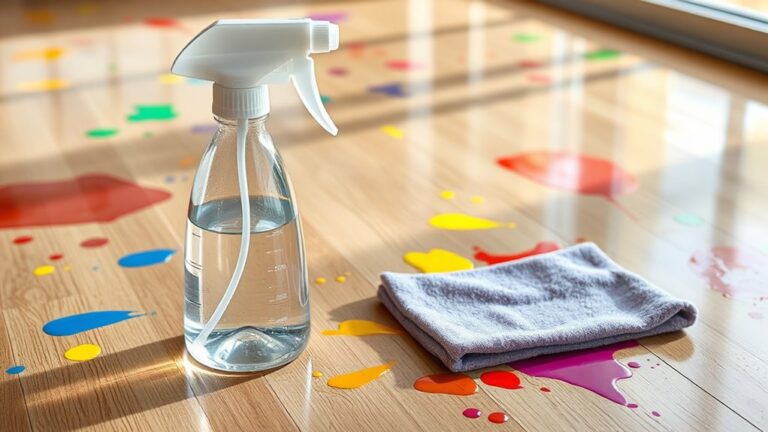Hybrid resilient flooring works by combining multiple layers designed for strength, comfort, and durability. You’ll find a tough wear layer that resists scratches and stains, backed by core materials like WPC or SPC offering dimensional stability and waterproofing. This layered structure absorbs impact while preventing moisture infiltration, making it ideal for humid areas. Installation relies on subfloor compatibility, with options like click-lock or glue-down. If you want to understand installation, maintenance, and lifespan specifics, keep exploring the details.
Composition and Layer Structure of Hybrid Resilient Flooring

Although hybrid resilient flooring combines various materials, its composition typically involves multiple distinct layers engineered for performance and durability. You’ll find that the layer thickness varies precisely according to the desired resilience and stability, balancing comfort with structural integrity. Each layer’s material properties are meticulously selected to optimize wear resistance, water resistance, and dimensional stability. The surface layer features a durable wear layer with enhanced scratch and stain resistance, while underlying layers provide cushioning and support. This precise layering guarantees that the flooring absorbs impact, resists deformation, and maintains its appearance over time. Understanding this structured assembly grants you the freedom to choose flooring that meets your specific environmental and functional demands without compromising on longevity or comfort.
Core Materials and Their Benefits
When selecting hybrid resilient flooring, the core material plays a pivotal role in defining its overall performance characteristics. Understanding the core benefits associated with different material types helps you make an informed choice based on your needs:
- Wood Plastic Composite (WPC) – Offers dimensional stability and enhanced comfort underfoot due to its rigid yet lightweight structure.
- Stone Plastic Composite (SPC) – Provides superior density and hardness, resulting in exceptional durability and resistance to dents.
- High-Density Fiberboard (HDF) – Balances strength and flexibility, allowing for easier installation while maintaining structural integrity.
Each material type delivers specific advantages that affect impact resistance, flexibility, and longevity. By considering these core benefits, you gain freedom to select flooring that aligns precisely with your environment and usage demands.
Waterproof and Moisture Resistance Properties

Since hybrid resilient flooring is often installed in areas prone to moisture exposure, understanding its waterproof and moisture resistance properties is crucial for guaranteeing long-term performance. The flooring incorporates a sophisticated moisture barrier within its core, preventing water infiltration from subfloors or spills. This barrier effectively blocks moisture vapor transmission, maintaining structural integrity and preventing warping or delamination. Additionally, the top layers exhibit high water resistance, allowing surface liquids to bead and be wiped away without damage. This combination of a robust moisture barrier and superior water resistance guarantees the flooring withstands humid environments, bathrooms, and kitchens without compromising durability. By selecting hybrid resilient flooring, you gain freedom from moisture-related concerns, enhancing both functionality and longevity in spaces where water exposure is inevitable.
Surface Wear Layer and Durability Features
You’ll find that the surface wear layer in hybrid resilient flooring is typically composed of advanced polymers designed to enhance scratch and stain resistance. This layer acts as a critical barrier against daily abrasion and chemical exposure, extending the sol‘s lifespan. Additionally, integrated UV protection helps prevent discoloration and material degradation from prolonged sunlight exposure.
Composition of Wear Layer
A hybrid resilient flooring’s wear layer typically consists of multiple components engineered to maximize surface durability and resistance to abrasion. Understanding the composition helps you appreciate the advanced wear layer materials and durability factors that guarantee long-lasting performance. The wear layer includes:
- Clear polyurethane or aluminum oxide coating – Provides a protective barrier against scratches and scuffs without compromising flexibility.
- Cross-linked polymers – Enhance structural integrity, improving resistance to impact and wear over time.
- Embedded additives – Such as UV stabilizers and anti-slip agents, which extend lifespan and maintain safety under various conditions.
These components combine precisely to create a robust surface that balances toughness with freedom from excessive rigidity, allowing you to enjoy durable flooring without sacrificing comfort or style.
Résistance aux rayures et aux taches
Although hybrid resilient flooring is engineered for durability, its scratch and stain resistance largely depends on the wear layer’s composition and protective coatings. This surface wear layer is typically a high-density polyurethane or enhanced polymer resin that forms a robust shield against mechanical abrasion. The scratch resistance you get is directly related to the hardness and flexibility balance in this layer, allowing it to absorb impacts without visible damage. For stain resistance, the wear layer’s chemical formulation repels common household substances like oils, dyes, and acids, preventing permanent discoloration. Additionally, cross-linked polymers in the coating create a non-porous barrier, guaranteeing liquids don’t seep through to the core. By choosing hybrid flooring with advanced wear layers, you guarantee long-lasting protection that maintains freedom from surface imperfections and stains over time.
UV Protection Benefits
Since UV exposure can degrade flooring materials over time, hybrid resilient flooring incorporates specialized surface wear layers designed to block or absorb ultraviolet rays. This UV protection is essential to maintaining the flooring’s appearance and structural integrity under constant sun exposure. When you choose hybrid resilient flooring, you’ll benefit from:
- Enhanced durability – The wear layer resists discoloration and brittleness caused by UV rays, extending the floor’s lifespan.
- Color retention – Advanced UV inhibitors prevent fading, keeping your flooring vibrant despite prolonged sun exposure.
- Surface stability – UV-resistant coatings reduce degradation, ensuring the surface remains smooth and resistant to cracking or warping.
Installation Methods and Subfloor Compatibility
When preparing for hybrid resilient flooring installation, understanding the compatibility of your subfloor with various installation methods is essential. Different installation techniques demand specific subfloor requirements to guarantee peak performance and longevity. Whether you choose glue-down, click-lock, or loose lay, your subfloor must be clean, dry, and level within strict tolerances. Here’s a quick reference:
| Installation Technique | Compatible Subfloor Types | Key Subfloor Requirements |
|---|---|---|
| Glue-Down | Concrete, Plywood | Humidité < 3%, smooth, flat |
| Click-Lock | Plywood, OSB, Concrete | Level within 3/16″ over 10 feet |
| Loose Lay | Concrete, Existing Vinyl | Clean, dry, flat, minimal debris |
| Double Glue Down | Béton | Humidité < 1.5%, extremely flat |
| Floating (Unattached) | Plywood, OSB | Stable, level, no moisture issues |
Choose your method based on subfloor conditions and desired freedom in installation.
Comfort and Sound Absorption Qualities

Because hybrid resilient flooring combines multiple materials in its construction, it offers enhanced comfort underfoot compared to traditional hard surfaces. You’ll experience improved comfort levels due to its layered design, which cushions each step and reduces fatigue. Additionally, its acoustic performance minimizes noise transmission, making your space quieter.
Here’s how it achieves that:
- Core Material: The dense, yet flexible core absorbs impact, providing a soft feel.
- Surface Layer: A resilient top layer reduces sound reflection and footstep noise.
- Underlayment Compatibility: Many hybrids incorporate or support sound-absorbing underlayments, boosting acoustic performance.
This combination not only improves comfort but also creates a more peaceful environment, giving you freedom to move and live without distractions from noise or discomfort beneath your feet.
Maintenance and Longevity Considerations
Although hybrid resilient flooring is designed for durability, proper maintenance is crucial to preserve its appearance and structural integrity over time. You’ll want to implement specific cleaning techniques, such as using pH-neutral cleaners and avoiding abrasive tools that can damage the wear layer. Regular sweeping or vacuuming prevents grit accumulation, reducing surface scratches. Address spills immediately to prevent staining or moisture infiltration. Lifespan expectations typically range from 15 to 25 years, depending on traffic and care. To maximize longevity, avoid excessive moisture exposure and use protective pads under furniture. By following these precise maintenance protocols, you guarantee your flooring maintains its resilience and aesthetic appeal, granting you freedom from frequent replacements or repairs. Consistent attention to cleaning and care directly extends your flooring’s functional life without sacrificing performance.




